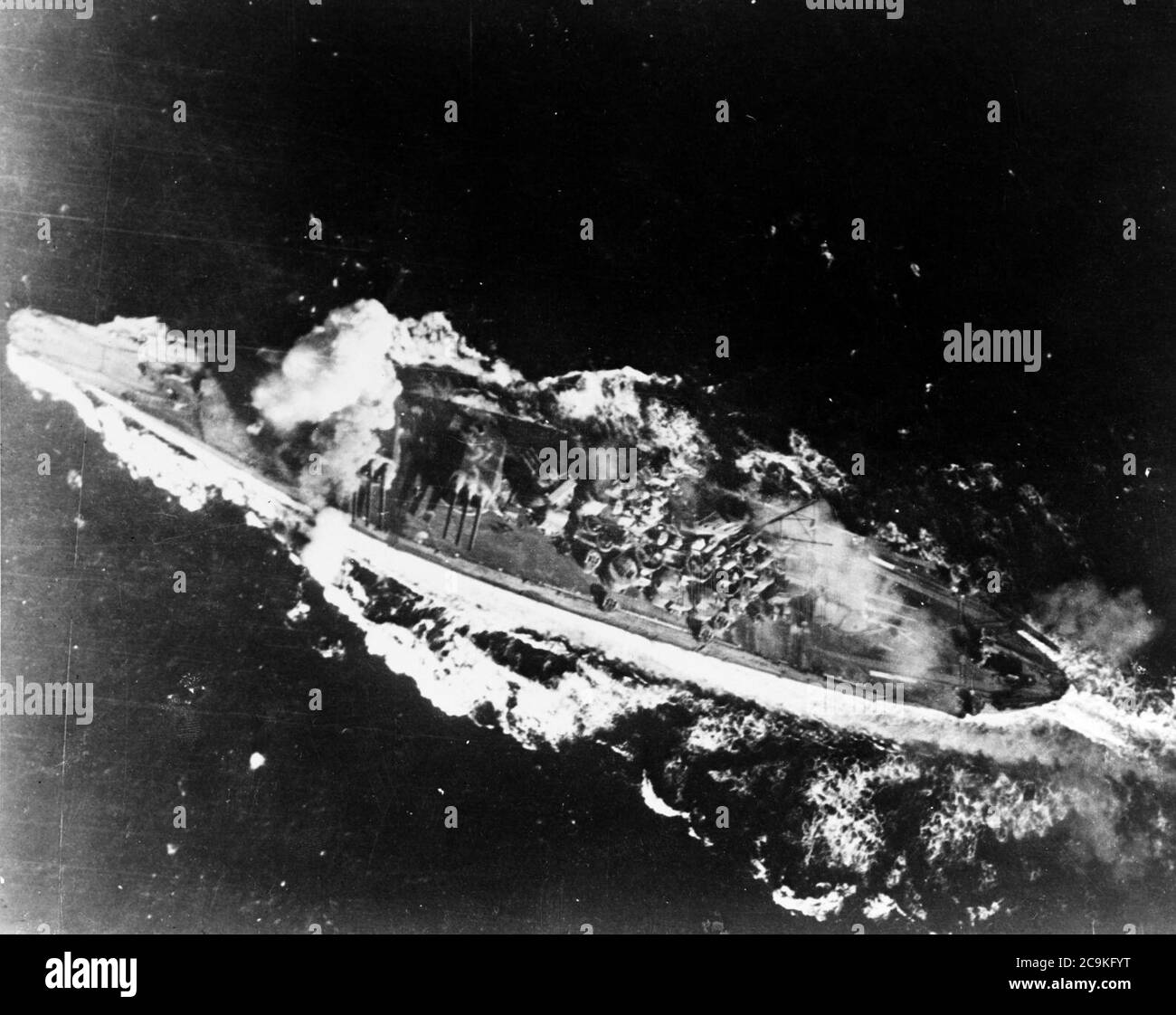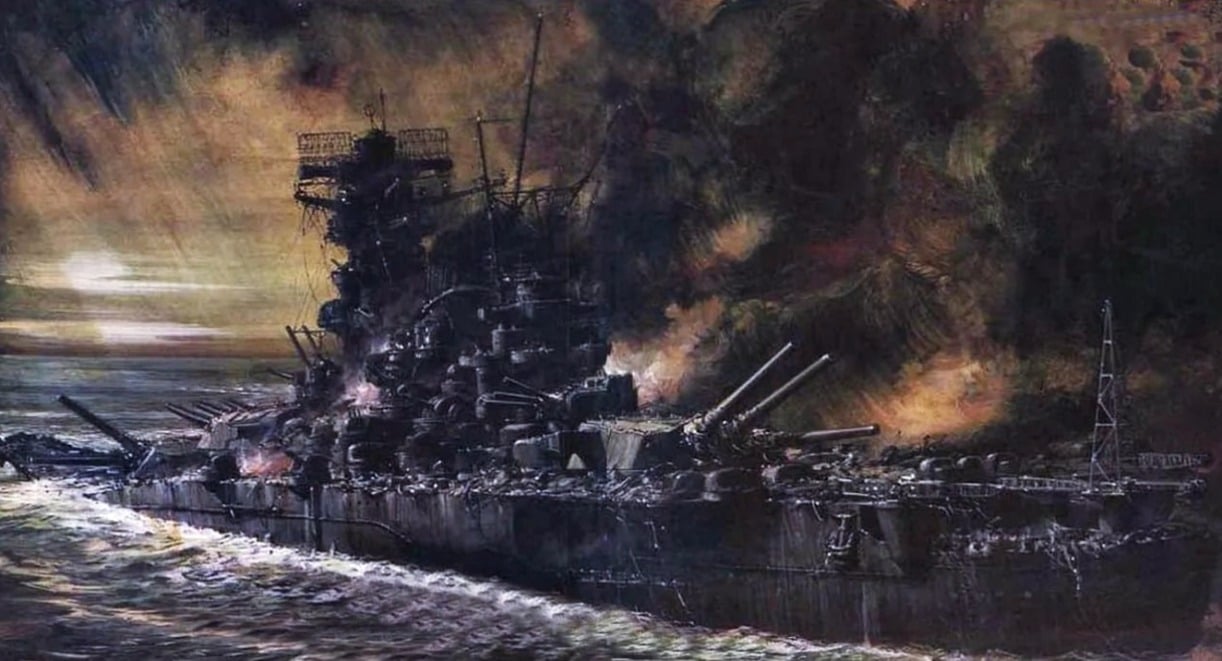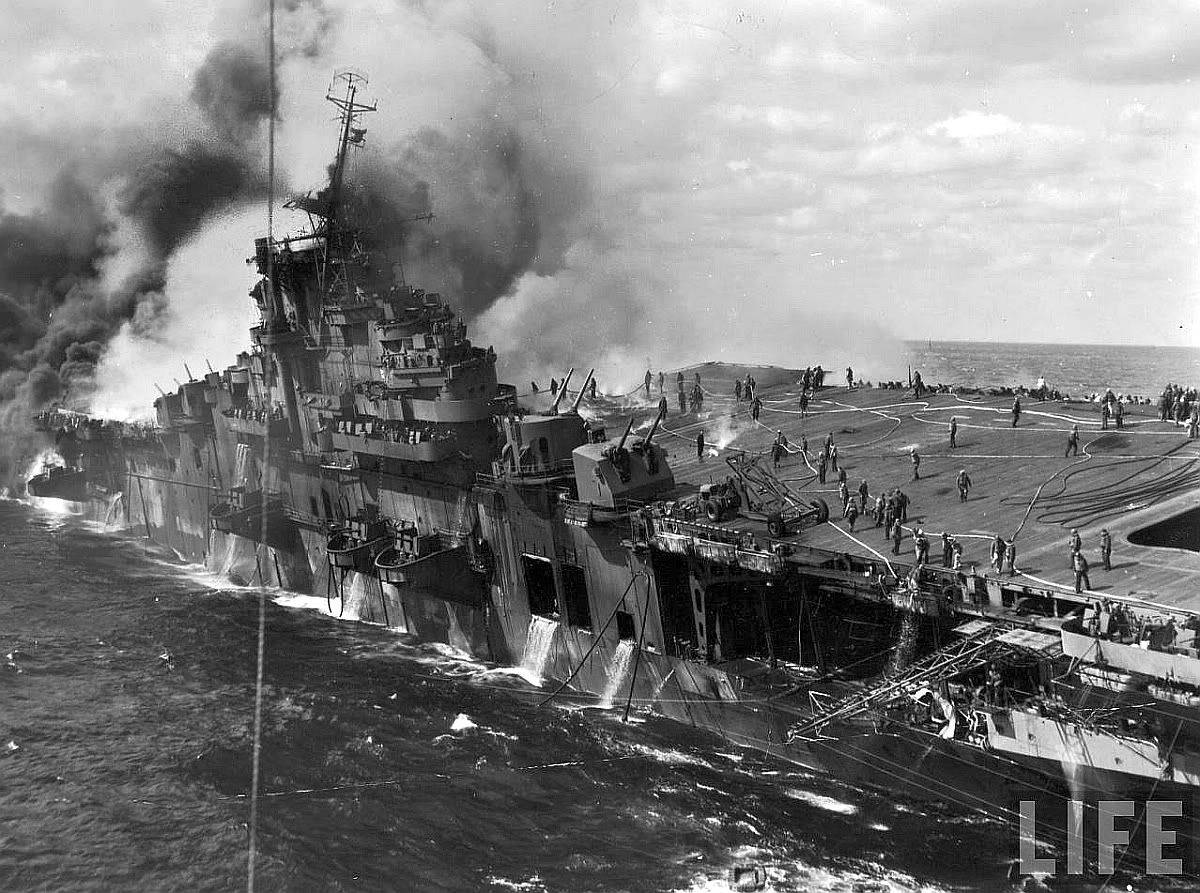Sinking Battleship Yamato - The Yamato (lit. 'Great Harmony') was the first battleship class built for the Imperial Japanese Navy (IJN) shortly before World War II. She and her sister ship Musashi are the heaviest and most heavily armed warships ever built, displacing about 72,000 tons (71,000 long tons) fully loaded and displacing 94 guns of 46 cm (18.1 m) in, nine types. It was the largest gun ever mounted on a battleship.
Yamato, named after the Yamato province of Japan, Yamato was designed to counter the numerically superior battleships of the United States, Japan's main rival in the Pacific. She was laid down in 1937 and officially commissioned a week after the attack on Pearl Harbor in late 1941. Throughout 1942, Admiral Isoroku Yamamoto served as head of the combined fleet, leading the fleet from the bridge during the Battle of June 1942. Midway, the devastating defeat of Japan. Musashi became head of the Combined Fleet in early 1943, and Yamato spent the rest of the year rotating between the main Japanese naval bases at Truk and Kure in response to American threats. In December 1943, Yamato was torpedoed by an American submarine, requiring repairs at Kure and refitting in early 1944 with additional anti-aircraft guns and radar. Don't take part in war.
Sinking Battleship Yamato

Yamato fired her main guns only once against land targets in October 1944 and was used to monitor the American invasion of the Philippines during the Battle of Leyte Gulf. During the Battle of Samar, she threatened to sink American transports against the light escort carriers of US Navy Task Force 77 "Taffy 3". Convinced by American airstrikes that they were seeing a powerful American carrier fleet, the Japanese turned back.
Death Of The Super Battleship Yamato And Musashi
In 1944, the balance of naval power in the Pacific shifted decisively against Japan, and in early 1945, severe fuel shortages in the Japanese archipelago severely depleted the fleet and seriously crippled it. In a desperate attempt to slow the Allied advance, Yamato was sent on a one-man mission to Okinawa in April 1945, ordering himself to beach, fight until destroyed, and defend the island. The task force was spotted by US submarines and aircraft south of Kyushu and sunk by US carrier-based and torpedo bombers on 7 April 1945, losing most of its crew.
In the 1930s, the Japanese government adopted an ultra-nationalist struggle aimed at greatly expanding the Empire of Japan.
After withdrawing from the Washington Naval Treaty, which limited the size and power of capital ships, the Imperial Japanese Navy began designing the new Yamato-class heavy battleships. Their planners realized that if war broke out, Japan would not be able to compete with the output of US Navy shipyards, hence the 70,000 tons.
The Yamato-class ships are designed to accommodate multiple Emmi warships simultaneously.
Battleship Yamato Under Fire Before Being Sunk, April 7, 1945 [1280 X 869]
She was cremated on 4 November 1937 at the Kure Naval Arsenal in Hiroshima.
The dock has been deepened by one meter and is equipped with a gantry crane capable of lifting up to 350 tonnes.
In Japan, great efforts were made to ensure that the ship was built in the utmost secrecy to prevent American intelligence officials from learning of its existence and characteristics.

Yamato's main armament consisted of 45 caliber 46 cm (18.1 in) Type 94 guns.
The Imperial Navy's Final Sortie
This shell was not as heavy as the shells fired by the British 18-inch naval guns of World War I. Each gun was 21.13 meters (69.3 ft) long, weighed 147.3 tons (162.4 short tons) and was capable of firing anti-aircraft guns. 42 kilometers (26 mi) of explosive or armor-piercing rounds.
Secondary armament consisted of twelve 155 mm (6.1 in) guns in four triple turrets (one forward, one aft and two amidships) and twelve 12.7 cm (5 in) guns, mounted in twin turrets (three on each side amidships). . These turrets were removed from Mogami class cruisers and converted to 20.3 cm (8 in) guns. In addition, Yamato mounted twenty-four 25 mm (1-inch) anti-aircraft guns primarily aboard.
The secondary armament configuration was changed to six 155 mm and twenty-four 127 mm guns, and the number of 25 mm anti-aircraft guns was increased to 162.
Between October and November 1941, Yamato underwent sea trials and reached a speed of 27.4 knots (50.7 km/h; 31.5 mph).
The Explosion Of The Japanese Battleship Yamato Was Epic
As the war continued, priority was given to speeding up military construction. On 16 December, months ahead of schedule, the battleship was officially commissioned at Kure with more ceremony than usual.
On the same day, under the command of Captain (later Lt. Admiral) Gihachi Takayanagi, he joined the battleships Nagato and Mutsu in the 1st Battleship Division.
A veteran of Japan's crushing victory over Russia at the Battle of Tsushima in the Russo-Japanese War, the Pearl Harbor victor was planning a decisive operation with the US Navy at Midway Island. After participating in the maneuvers, Yamato departed Hiroshima Bay on 27 May for duty with Yamamoto's main battleships.

US codebreakers were aware of Yamamoto's intentions, and the Battle of Midway had devastating consequences for the Japanese carrier force, with the loss of four fleet carriers and 332 aircraft.
Minecraft, Sinking Yamato. By Worldofpeter12 On Deviantart
However, his battle plan spread his forces too far to trap the Americans, and the battleship group was too far away to take part in the operation.
On 5 June, Yamamoto ordered the remaining ships to return to Japan, so Yamamoto withdrew to Hashirashima with his main battleship before returning to Kure.
After spending 11 days at sea, she was sighted by the American submarine USS Flying Fish. Yamato arrived safely on the truck that day.
This was due to the lack of suitable 46 cm ammunition to fire on Guadalcanal, the unknown waters around Guadalcanal, and high fuel consumption during the campaign on Guadalcanal.
Wreck Of Battleship Yamato
On 11 February 1943, Yamato was replaced by her sister ship Musashi as head of the combined fleet.
From her arrival in August 1942 until her departure on 8 May 1943, the battleship was only one day away from Truk.
After sailing for the Seto Inland Sea off western Japan, she re-entered the docks in late July and underwent extensive modifications and improvements. On 16 August, Yamato began returning to Truk to join a larger task force formed in response to the American attacks on Tarawa and Makin Atolls.

She sortied with Nagato, three carriers, and small battleships in late September to intercept Task Force 15, and again a month later with six battleships, three carriers, and an advanced cruiser. Sorted at the bottom. Intelligence had reported that there were some ships at the US naval base at Pearl Harbor.
Dead Battleship: How Japan's Monster Yamato Warship Committed Naval Suicide
However, there was no radar contact for six days and the fleet returned to the trucks on 26 October.
Subsequently, the Yamato and Musashi were pressed into service as transport ships due to their large storage capacity and thick armor protection.
On 25 December, while transporting troops and equipment from Yokosuka to Truk, which had been called in as reinforcements for the outposts of Kavig and the Admiralty Islands, Yamato and his task group encountered the American submarine skate about 180 miles (290 km) away. Blocked. in the sea
Skate fired four torpedoes at Yamato. One struck the starboard side of the battleship towards the stern.
Squall Line: Yamato
Five meters (16 ft) below the top of the anti-torpedo bulge, a hole about 25 meters (82 ft) wide was torn through the hull, the joints between the upper and lower armor strips were broken, and the aft turret was broken. The upper tract will flood.
On 16 January 1944, Yamato arrived at Kure for repairs to her torpedo damage and remained in drydock until 3 February.
At this time, 45° sloping armor plates were fitted to the damaged part of the hull. The 5,000 long tons (5,100 t) of steel armor would be used to increase the ship's defenses against flooding torpedoes from outside the fortress, but the extra weight would reduce Yamato's strength. It was out of hand. increases. Too much displacement and draft.

From 25 February to 18 March 1944, Yamato was again dry-docked at Kure for further upgrades to all her radar and anti-aircraft systems.
The Yamato Was Hell To Sink—and It Went Out With A Bang Like A Nuclear Blast
The two beam-mounted triple 6.1 in (155 mm) gun turrets each were removed and replaced with three pairs of 5 in (127 mm) anti-aircraft guns. Additionally, 8 triple and 26 single 25mm AA guns were added, increasing the total number of 127mm and 25mm AA guns to 24 and 162 respectively.
Shelters were also added on the upper deck for increased anti-aircraft crews. A Type 13 air detection and a Type 22 Mod 4 surface detection/gunnery control radar were installed and the main mast was modified. Her radar suite has been upgraded to include an infrared identification system and aircraft detection and gunnery control radars.
Yamato left Kure on April 21, and the next day he loaded troops and supplies at Okinoshima.
Lego battleship yamato, japanese battleship yamato, space battleship yamato 2205, battleship yamato model kit, space battleship yamato 2202, yamato sinking, battleship yamato sinking, battleship sinking, battleship yamato, yamato battleship model, space battleship yamato model, space battleship yamato

0 Comments